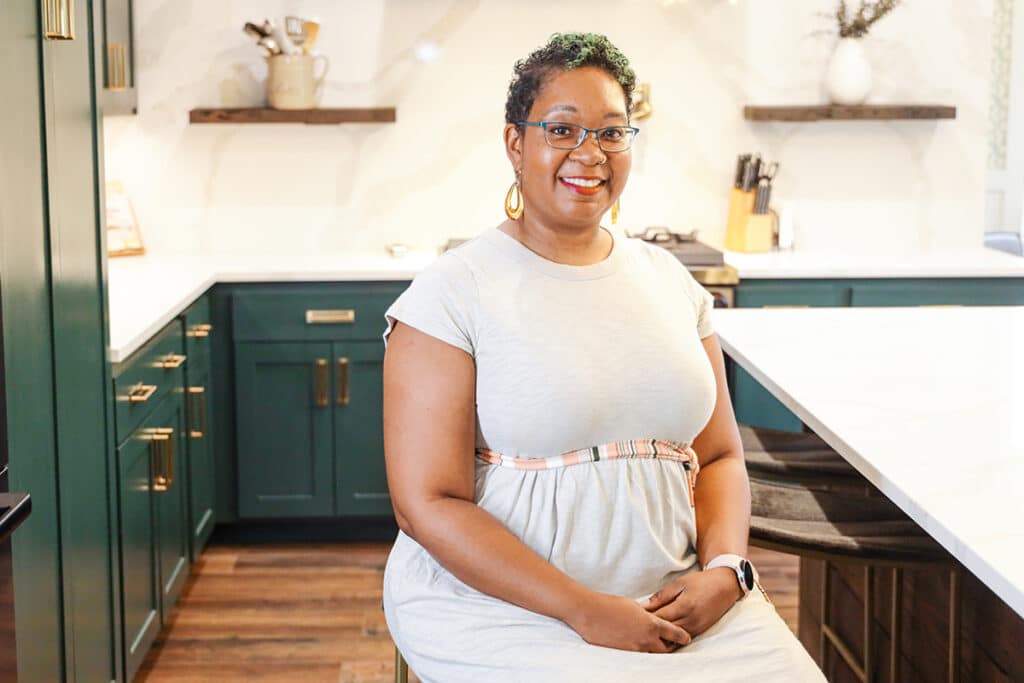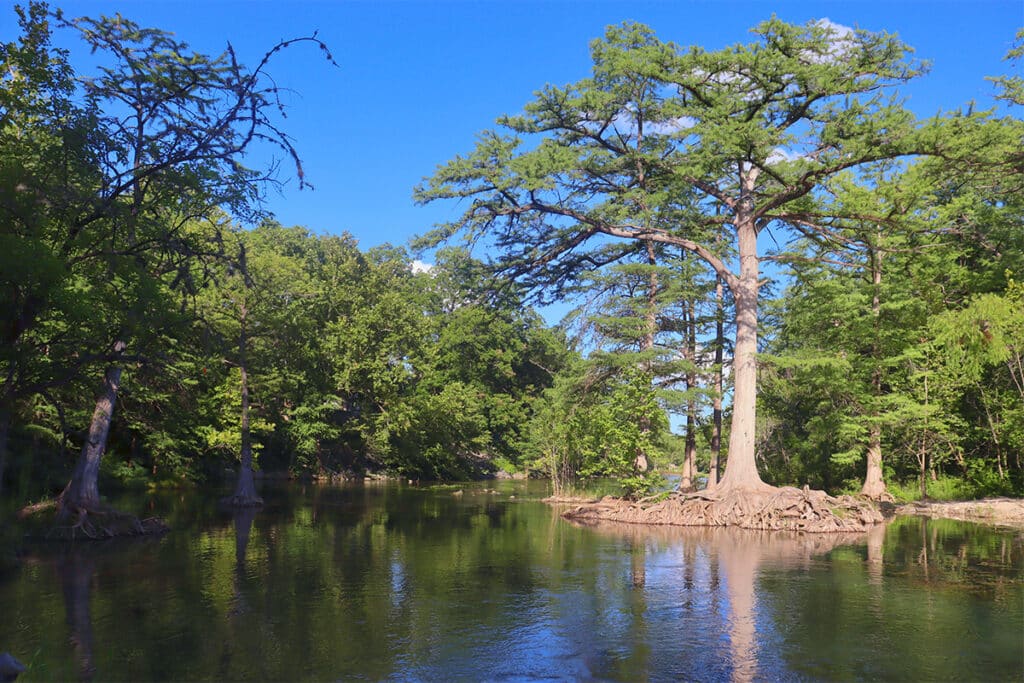This is a story about a house that was a dream. A dream born of travels to sunny Spain, lingering hours spent in the Alhambra and countless hours studying Moorish architecture. It is a story about Al Aguilar and Gisela Girard, a couple with the creative drive to build a home that reflects not only the Spanish architecture they admire but the desire to craft a retreat that could be shared with family and friends.
Welcome to Dos Sueños.
“Dos Sueños means two dreams in Spanish,” says Gisela. “My mother thought of the name. She said our house is a reflection of the dreams of two people, and it seems to fit. This house is a culmination of our dreams.”
“We were inspired to build Dos Sueños by our travels in Spain and particularly the region of Andalusia,” says Al. “We saw the fountains, the arches and beautiful gardens. We wanted to build that here in San Antonio.” Before they could build the dream, they needed a site. Because their advertising agency, Creative Civilization, is located in downtown San Antonio, they didn’t want a location that would be a long drive. Yet they wanted acreage, too, and a bit of tranquillity.
During a drive in the hills north of the La Cantera resort, Gisela saw a sign, Acreage for sale.”Gisela told me she’d found a place with a view of the sunset,” says Al. “She told me to go see it right away.” It turned out that the owner had bought land as a surprise for his fiancee from New York City. He thought she’d enjoy the views, but she didn’t care for the eight-acre site because she was a city girl. Dejected, he sold the land to Al and Gisela. One dream ended, and another began. “We studied the land and researched the kind of architecture we wanted before we chose an architect,” Al says. “We knew the right architect could help us position the residence for the best effect.”
After much consideration, they chose Michael G. Imber, Architect, PLLC. “We had seen a hacienda-style house he had designed,” Gisela recalls. “Now he’s wellknown, but back then he was just beginning to make a name for himself. He captured the essence of the designs and buildings we saw in Spain, even though he’d never been there. It was amazing!” Dos Sueños is hidden among the trees, much as a dream is often hidden in the heart. Entrance is gained through an electronic gate, along a narrow, winding road. At first, it seems there is no house, only Hill Country vegetation. Then suddenly the house appears, white and pristine on the brow of the hill. The house is revealed through a progression of entrances beginning in the garden court. The classic Moorishshaped star is featured in the auto court, along with a colorful Spanish-tiled fountain. A set of three large double doors with iron scrolls leads to the Zaguan, a groin-vaulted loggia entrance flanked by classic cut-stone octagonal columns and leaded glass transoms. The stained and scored concrete floor is inlaid at intervals with the Moorish star.
The main gallery is filled with light on sunny days. It connects the master suite with the public living areas and the stairway that leads to the guest room and Gisela’s office. Music flows through the gallery and spills outdoors because the home is wired for the music the couple loves so much. The principal sala features a coffered beam ceiling of longleaf pine. “The wood, which is very rare today, was rescued from a cotton mill that was being demolished in Galveston,” says Al. The fireplace in the corner has a molded plaster surround, handcrafted the way artisans used to make them — one layer of plaster at a time. The hand-hammered decorative copper smoke hood is patterned with the Moorish star found throughout the home. The small bar built into another corner has its own story. “The tile on the bar is from a castle in Spain,” Al says. He explains that it is azulejos, an ancient form of Spanish painted, tin-glazed, ceramic tile work. “We found it on our travels in Sevilla, Spain, and bought it as an antique. We knew we’d find a place for it in our home.” A thick, intricately designed wood piece inlaid over the bar is another antique, this time from Morocco. The furnishings in the room have been collected over the years. The velvety textures on the chairs from Fredericksburg are a stark contrast to the primitive wood of the huge table in the center of the room. “The coffee table is actually an old antique door,” Gisela says. “It is so heavy that it takes several people to move it.” The iron chandeliers in the principal room have their own story. “We purchased one of the chandeliers in Austin,” Al says. “It was imported from France as an antique and was the only one of its kind. We took it to an artisan, who created a twin so we’d have a matching set. The craftsmanship is beautiful in both pieces.” End tables from Mexico came from another store in Fredericksburg, and the iron and glass occasional table in the corner of the room is Italian. The grand piano, which Al plays, is another reminder of the importance of music in the home.
The library, to the right of the fireplace, is the essence of order and peace.”This is a real library, not just a decoration. We use it to meditate and to read,” Gisela says. The round wooden table in the center of the small room is very old and from Mexico. The four antique leather chairs around it once belonged to a colonel. The books in the ceiling-height shelves are organized by subject, and there isn’t an empty place on the shelves. Any space that isn’t devoted to books displays angels made by Gisela’s grandmother. To the left, an arabesque arch leads into the dining room, where the focus is the mesquite table and chairs seating 12 that the couple purchased in San Miguel de Allende. The wooden sideboard from Peru holds the family’s china and crystal. Pride of place is reserved for the beautiful chandelier. “It came to us from New York,” says Al, “but it was originally housed in an old Spanish church. I love how angels are worked into the metal around the light source.” Beyond the dining room is the spacious kitchen, a gourmet ‘s delight. The white and light green color scheme is repeated throughout the kitchen in the Moroccan tile and the cabinetry. A Moorish light fixture hangs near the sink. The European pots hanging from a rack over the island and the smell of the scones Gisela has recently removed from the oven are a reminder of her skill as a baker. Perpendicular to the island is a long ironwood table from Argentina used for informal dining. The wall of windows just beyond the table floods the kitchen in natural light.
The kitchen spills into an open-air dining loggia. “This is my favorite place in the house,” Gisela says. “We eat out here and watch the sun set.” The view to the east is equally dramatic, overlooking the pool and natural landscape. The stair tower and its timber balcony overlooking a gallery below house the guest floor with two rooms that enjoy spectacular views of the western horizon. One room serves as Gisela’s office and darkroom, and the other is a guest room. A series of arabesque arches leads from the kitchen down the main gallery to the master bedroom suite. A private patio is wedged into place here, holding seating and Gisela’s potted garden of peppers, herbs and tomatoes. French doors lead from the patio into the bedroom, whose high ceiling is complemented by the large sleigh bed in the center of the room. The headboard and footboard are covered in rich dark leather, and their coloring is repeated in the intricate Moroccan screens that serve as window treatments at the end of the room.
“This is a Hereke rug we purchased in Turkey,” Al says, pointing to a silk-on-silk carpet that hangs on the wall. “It is old and very special.” He explained that Hereke rugs are the finest hand-knotted carpets in the world. An Ottoman emperor established the Hereke factory to make rugs exclusively for the Ottoman Empire. These carpets are now prized by collectors throughout the world. A little vanity belonging to Gisela’s great-grandfather contains collectors’ items of a different sort. Statuary collected during travels over the years and as gifts from friends and family creates a small shrine to a variety of saints, most notably Santa Barbara.”Santa Barbara is the patron saint of lightning,” Gisela says wryly.”We have a lot of lightning up here in the hills!” Across from the master bedroom is the master bath, a fabulous example of how dramatic tile work can spice up an otherwise utilitarian space. A tall, colorful tile wall mimics a Spanish fountain and serves as a backdrop for the large tub, made for a long soak at the end of the day. Behind the wall is a double shower. The room is divided into his and hers. The left side is Gisela’s, with her sink, vanity and built-in drawers leading into a walk-in closet with a window at the end. A three-way mirror is installed on the left side of the closet, a thoughtful addition for a woman who needs to dress in a hurry. Gisela’s water closet has a door that opens into a room designed to store luggage and bulky bedding. “My wife is one smart woman,” Al says. “I don’t know anyone else who would think of this.” Al’s side of the bathroom has its own set of built-ins and its own closet. “Mine, however, is not so full,” he comments with a smile. Down the hall and behind two pocket doors is Al’s lair, the media room. Comfortable leather couches are strategically arranged to provide the best view of the wide-screen television. “I love watching the University of Texas games,” he says. Paintings and sculpture by important local and international artists are carefully placed throughout the home. Art is very important to Al and Gisela, and they are quite knowledgeable on the subject.
As with traditional Spanish homes, Dos Sueños’ interior spaces are all tied back to the landscape by loggias, balconies, porches and courtyards accented by natural light and the sound of falling water from fountains. Every window offers a beautiful view of the Hill Country or the gardens, which are Gisela and Al’s pride. They spend weekends outdoors, potting, planting and trimming, tending their acreage. When Gisela isn’t working or gardening, she paints at the small studio she calls Villa Gisela. It’s a freestanding studio accented by a long room with a covered porch. “We come here to paint and read the newspaper,” Gisela says. “Sometimes family members come here to paint with me. It’s a great way to relax and express my creativity.” Al loves to play with their dogs. They have two Great Pyrenees, used to protect the property from coyotes. The two gentle giants share what Al jokingly calls the Dog Condo with three other canines.
“After they see our home, people always ask me how I can leave it every day to go to work,” Gisela says. “It is difficult some days because I love it here. I love coming home to the peace and serenity we’ve created, though, so that makes leaving a little easier.”
“We enjoy sharing our home,” Al adds. “Entertaining is fun for us, and the house is built for it. We have parties and entertain clients. Our families are frequently here, too, because several of Gisela’s family members live nearby.”
“Every time I show someone our home, it reminds me of how we put it together,” Gisela says. “It really did start out as our dream. We pulled it together a little bit at a time. It’s such a pleasure to relive the memories.”
“As advertising people, our job is to be creative and to provide vision for our clients,” Al says. “But we can also express our creativity and our vision in our home. And every day, we get to live our dream.”
Author: Robyn Barnes
Photographer: Al Rendon




